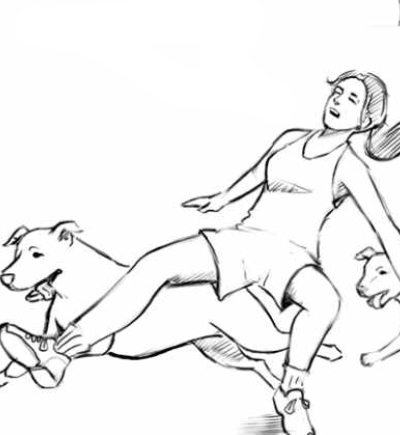Knee symptoms can be confusing. When speaking to the doctor or physiotherapist about your knee, being able to describe the exact symptoms will help with diagnosis.
 Page updated June 2024 by Dr Sheila Strover (Clinical Editor)
Page updated June 2024 by Dr Sheila Strover (Clinical Editor)

It is important to mention whether or not the knee symptoms came on after an injury, or whether they just appeared on their own.
Knee symptoms after an injury
Immediate pain, rapid balloon-like swelling and incapacity suggests a disrupted vascular structure within the knee capsule, such as a torn cruciate ligament, a torn meniscus, or a bone fracture. Locking may indicate a torn structure blocking full joint extension.
Structures outside the capsule (eg collateral ligament) may have less dramatic symptoms when injured.
-
Quote from peer-reviewed paper:
"....The [anterior cruciate ligament] is the most frequently ruptured ligament in the human body. It is often associated with the tearing of the fibers of the medial and lateral collateral ligaments, owing to their proximity to the ACL"
Citation: Shom P, Varma AR, Prasad R. The Anterior Cruciate Ligament: Principles of Treatment. Cureus. 2023 Jun 11;15(6):e40269. doi: 10.7759/cureus.40269. PMID: 37448400; PMCID: PMC10336184.
-
Quote from peer-reviewed paper:
"The medial collateral ligament (MCL).... [is injured] as a result of either a direct valgus force to players’ knees or cutting maneuvers, when athletes plant a foot and suddenly shift their direction or speed...."
Citation: Vosoughi F, Rezaei Dogahe R, Nuri A, Ayati Firoozabadi M, Mortazavi J. Medial Collateral Ligament Injury of the Knee: A Review on Current Concept and Management. Arch Bone Jt Surg. 2021 May;9(3):255-262. doi: 10.22038/abjs.2021.48458.2401. PMID: 34239952; PMCID: PMC8221433.
-
Quote from peer-reviewed paper:
"....Meniscal tears can cause a range of symptoms, including pain localizing to the joint line, swelling, clicking, catching, locking, and the classic “giving away” of the knee. They are more commonly seen in men as compared to women, with up to 80% of all meniscal tears being reported in men...."
Citation: Bhan K. Meniscal Tears: Current Understanding, Diagnosis, and Management. Cureus. 2020 Jun 13;12(6):e8590. doi: 10.7759/cureus.8590. PMID: 32676231; PMCID: PMC7359983.
-
Quote from peer-reviewed paper:
"....Fractures of the patella account for about 1% of all skeletal injuries and can lead to profound impairment due to its crucial function in the extensor mechanism of the knee....."
Citation: Gwinner C, Märdian S, Schwabe P, Schaser KD, Krapohl BD, Jung TM. Current concepts review: Fractures of the patella. GMS Interdiscip Plast Reconstr Surg DGPW. 2016 Jan 18;5:Doc01. doi: 10.3205/iprs000080. PMID: 26816667; PMCID: PMC4717300.
-
Quote from peer-reviewed paper:
"The common underlying causes of knee stiffness are injuries, infection, ....fracture fixation, arthroscopic surgery....and knee arthroplasty....[E]xtension loss is usually due to adhesions in the intercondylar notch or tibio-femoral compartments. In contrast, the loss of flexion is mostly due to adhesions in the suprapatellar pouch or the patello-femoral joint, and fibrosis or adhesion of the quadriceps muscles."
Citation: SVaish A, Vaishya R, Bhasin VB. Etiopathology and Management of Stiff Knees: A Current Concept Review. Indian J Orthop. 2020 Oct 20;55(2):276-284. doi: 10.1007/s43465-020-00287-0. PMID: 33927806; PMCID: PMC8046887.
Symptoms in the absence of injury
When there has been no injury, but the patient is experiencing pain or swelling, the doctors will investigate anatomical anomalies, like foot issues, twists in the bones, metabolic disorders.
-
Quote from peer-reviewed paper:<
"....The main factors associated with unspecified knee pain among adolescents are being female, doing sports activities, being obese, and being older...."
Citation: Saes MO, Soares MCF. Knee pain in adolescents: prevalence, risk factors, and functional impairment. Braz J Phys Ther. 2017 Jan-Feb;21(1):7-14. doi: 10.1016/j.bjpt.2016.04.001. Epub 2017 Jan 13. PMID: 28442078; PMCID: PMC5537448.
-
Quote from peer-reviewed paper:
"....A lot of patients visit outpatient clinics due to a concern that the [knee] noise is pathological. In most cases, the noise is physiological, and it is sufficient to explain the cause of the noise to patients and reassure them...."
Citation: Song SJ, Park CH, Liang H, Kim SJ. Noise around the Knee. Clin Orthop Surg. 2018 Mar;10(1):1-8. doi: 10.4055/cios.2018.10.1.1. Epub 2018 Feb 27. PMID: 29564040; PMCID: PMC5851845.
Feeling uncertain about stability
Wearing away of the joint cartilage or the meniscus may cause a general wobbliness of the knee, but ligament tears are likely to cause instability in a particular direction.
A bit of broken joint cartilage or a loose flap of a torn meniscus can suddenly get caught temporarily between the bones in the knee, causing a sudden painful stumble which is called 'catching'.
Very often it is someone else who notices that your knee thrusts outwards with each step. This is called 'lateral thrust'. This can be due to a lack of the knee meniscus 'spacer' on one side. It is an issue which needs to be taken seriously as it means that the problem is still relatively early, when an intervention like an osteotomy or a meniscus transplant may restore function and prevent further damage.
-
Quote from peer-reviewed paper:
"....Chronic instabilities present with mechanical symptoms such as locking, catching, clicking, or giving way, particularly with twisting movements.....Stability of the knee joint is [normally] maintained by the shape of the condyles and menisci in combination with passive supporting structures....[t]hese are....ACL,...PCL,...MCL, and ....LCL."
Citation: Kakarlapudi TK, Bickerstaff DR. Knee instability: isolated and complex. West J Med. 2001 Apr;174(4):266-72. doi: 10.1136/ewjm.174.4.266. PMID: 11290686; PMCID: PMC1071355.
-
Quote from peer-reviewed paper:
"....Varus thrust is visualized during gait as the dynamic worsening or abrupt onset of varus (bow-leg) alignment as the limb accepts weight (stance phase), with a return to less varus and more neutral alignment during lift-off and the non-weightbearing (swing) phase of gait.....
Citation: Chang A, Hochberg M, Song J, Dunlop D, Chmiel JS, Nevitt M, Hayes K, Eaton C, Bathon J, Jackson R, Kwoh CK, Sharma L. Frequency of varus and valgus thrust and factors associated with thrust presence in persons with or at higher risk of developing knee osteoarthritis. Arthritis Rheum. 2010 May;62(5):1403-11. doi: 10.1002/art.27377. PMID: 20213800; PMCID: PMC2921866.